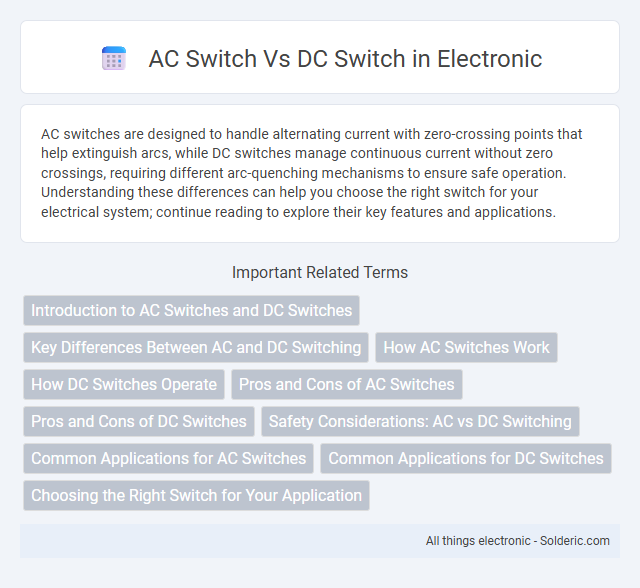AC switches are designed to handle alternating current with zero-crossing points that help extinguish arcs, while DC switches manage continuous current without zero crossings, requiring different arc-quenching mechanisms to ensure safe operation. Understanding these differences can help you choose the right switch for your electrical system; continue reading to explore their key features and applications.
Comparison Table
| Feature | AC Switch | DC Switch |
|---|---|---|
| Current Type | Alternating Current (AC) | Direct Current (DC) |
| Arc Extinguishing | Arc naturally extinguishes as current crosses zero | Arc does not extinguish easily due to constant current flow |
| Design Complexity | Less complex, standard for household & industrial use | More complex with stronger arc quenching mechanisms |
| Applications | Residential, commercial, and AC power systems | Solar systems, electric vehicles, battery systems |
| Contact Material | Common conductive metals | Special materials to resist arc welding and erosion |
| Voltage Ratings | Typically up to 600V AC or higher | High voltage DC switches designed up to several kV DC |
| Safety Considerations | Standard insulation and breaking capacity requirements | Enhanced insulation and safety due to sustained arcs |
Introduction to AC Switches and DC Switches
AC switches are designed to interrupt alternating current, handling voltage and current that periodically reverses direction, commonly used in household and industrial power supplies. DC switches manage direct current, which flows in a constant direction, requiring specialized contacts and arc extinguishing mechanisms due to the continuous nature of DC arcs. Both switch types are critical for ensuring electrical safety and equipment protection in their respective current environments.
Key Differences Between AC and DC Switching
AC switches are designed to handle alternating current, which periodically reverses direction, requiring them to interrupt current flow during zero crossings to minimize arcing. DC switches manage direct current, which flows continuously in one direction, necessitating more robust contact materials and arc-quenching mechanisms to safely break circuits without natural zero crossing points. The key differences between AC and DC switching lie in their arc suppression techniques, contact design, and ability to safely interrupt current flow under varying electrical characteristics.
How AC Switches Work
AC switches operate by interrupting the alternating current flow through a break in the circuit that opens and closes periodically to control electrical devices. The switch uses contacts that separate during the off state, creating a gap that prevents current from passing, while the AC waveform naturally crosses zero voltage, reducing arcing and wear on contacts. Your choice of an AC switch ensures safe and efficient handling of voltage reversals inherent in alternating current systems.
How DC Switches Operate
DC switches operate by interrupting the direct current flow through specialized contact designs and magnetic blowouts to handle continuous, unidirectional current. Unlike AC switches, DC switches must extinguish the arc without current zero-crossing, requiring faster separation and stronger arc quenching mechanisms. Your choice of a DC switch should consider its voltage rating, breaking capacity, and contact durability to ensure safe and reliable operation in DC circuits.
Pros and Cons of AC Switches
AC switches offer advantages such as the ability to interrupt current at the zero crossing point, which reduces electrical arcing and extends contact life. They are generally simpler and more cost-effective for use in household and industrial AC circuits. However, AC switches are less effective in DC applications where current does not naturally drop to zero, leading to increased arcing and faster contact wear.
Pros and Cons of DC Switches
DC switches offer precise control over direct current circuits, making them essential for renewable energy systems and electric vehicles where DC power is prevalent. Their ability to handle constant current without zero crossing enhances safety but often results in higher costs and increased complexity compared to AC switches. Limitations include potential arcing challenges and the need for specialized contacts to reliably interrupt DC currents.
Safety Considerations: AC vs DC Switching
DC switches require more robust insulation and contact materials due to the constant unidirectional flow of current, which makes arc extinction more challenging compared to AC switches. AC switches benefit from the alternating current's zero-crossing point, naturally aiding arc suppression and improving safety during switching. Proper selection of switches compliant with relevant standards such as IEC 60947 ensures enhanced protection against electrical faults and reduces the risk of fire hazards in both AC and DC applications.
Common Applications for AC Switches
AC switches are commonly used in residential and commercial lighting systems, HVAC equipment, and motor control circuits due to their ability to handle alternating current loads effectively. These switches efficiently interrupt current flow in AC power lines, ensuring safe operation of household appliances, industrial machines, and lighting fixtures. Their design accommodates voltage and current fluctuations typical in AC systems, making them ideal for power distribution and control in grid-based environments.
Common Applications for DC Switches
DC switches are commonly used in renewable energy systems, such as solar power installations, to control the flow of direct current from photovoltaic panels. They are essential in electric vehicles for managing battery circuits and ensuring safe disconnection during maintenance. Your choice of a DC switch enhances safety and reliability in applications where stable and precise interruption of direct current is required.
Choosing the Right Switch for Your Application
Selecting the right switch for your application depends on understanding the fundamental differences between AC switches and DC switches in handling current. AC switches are designed to interrupt alternating current, benefiting from the zero-crossing point that naturally extinguishes the arc, which makes them ideal for household appliances and industrial equipment. DC switches must manage a continuous, unidirectional current without a zero-crossing, requiring robust arc suppression mechanisms to ensure safe operation in battery systems or solar power installations.
AC switch vs DC switch Infographic

 solderic.com
solderic.com